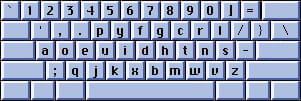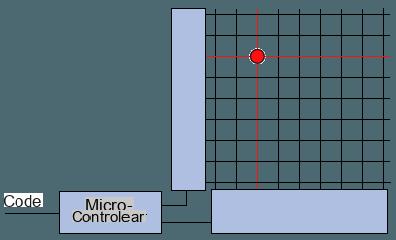Le keyboard (in English keyboard) allows, like typewriters, to enter characters (letters, numbers, symbols ...), it is therefore an essential input device for the computer, because it is thanks to him that it is possible for us to send orders.
Azerty
The term "QWERTY"(in connection with the first 6 alphabetic keys of the keyboard) indicates a type of keyboard, equipping almost all the computers in Our country and in Belgium. It is about the declension for the French-speaking countries of the keyboard QWERTY.
Qwerty
The keyboard Qwerty was designed in 1868 in Milwaukee by Christopher Latham Sholes by distributing on opposite sides of the keyboard the keys corresponding to the pairs of letters most used in the English language in order to prevent the stems (carrying the characters) of the typewriters of the time from crossing and jamming. This keyboard was sold to the Remington company in 1873. The Qwerty keyboard (and by extension the Azerty keyboard) was therefore designed from a purely technical perspective, against ergonomics and efficiency. Legend has it that the layout of the keys on the first line of the Qwerty keyboard was prompted by the typewriter vendors of the day in such a way that all the keys needed to write "typewriter" ("typewriter" to write "in English) are there when they were doing demonstrations!
Dvorak
In 1936, August Dvorak (professor at the University of Washington) developed a keyboard whose key layout is entirely designed in terms of efficiency. So the clavier Dvorak has been developed by arranging all the vowels of the alphabet and the five most used consonants on the central line, so as to allow their accessibility while promoting good alternation between left and right hands. On the other hand, the most frequent letters of the alphabet have been placed in the center of the keyboard.

Different studies have shown that the contribution of the Dvorak keyboard in terms of efficiency was meager in practice and that the effort required to switch from the Azerty or Qwerty keyboard to the Dvorak keyboard was too heavy for it to be necessary, which explains why all computers are still equipped with the Azerty / Qwerty keyboard today.
Keyboard connector
Keyboards are usually plugged into the back of the central unit, on the motherboard, on a USB connector or sometimes on a purple PS / 2 connector:

Operation
Each time you press a key on the keyboard, a specific signal is sent to the computer. The keyboard indeed uses a matrix network allowing each key to be identified by a row and a column.

When a key is pressed, an electrical contact is established between the row and the column. The electrical signals are transmitted to a micro-controller, which sends a code (BCD, ASCII or Unicode) to the computer describing the character corresponding to the key.
Types of keyboards
There are 4 types of keyboards for PC, the first three were invented by IBM, the last is the consequence of a modification due to the release of Microsoft Windows 95. Here are the four types of keyboard:
- the 83-key keyboard, PC / XT type
- The 84-key keyboard, PC / AT type
- The 102-key keyboard, also known as the extended keyboard
- The Microsoft Windows 105 compatible 95-key keyboard
PC / XT type keyboards
This is the first keyboard for PC, it has the particularity of being separate from the computer, unlike all the computers of the time (Apple II, Amiga, ...) for which the computer and the keyboard were one and the same.

This keyboard had 83 keys, but was criticized for the arrangement of the keys and their disproportions (in particular the Shift and Enter keys which were too small and badly placed). On the other hand, the communication between the keypad and the central unit was one way, which means that the keypad could not have an LED type display.
PC / AT type keypads
The PC / AT type keyboard, with 84 keys, equipped AT type PCs in 1984.

This type of keyboard corrects the errors of its predecessor by resizing in particular the Shift and Enter keys. On the other hand, this keyboard is bidirectional, that is to say that it can display states using LED displays. Finally, the motherboard fitted to AT-type PCs included a controller making it possible to configure:
- The repetition rate, that is, the number of characters sent per second when a key is pressed
- The repeat delay: the time after which the computer considers that the key is pressed, in order to differentiate a single key press (one character) from a long key press
Extended keyboards
New IBM compatible computers released in 1986 were equipped with keyboards with 102 keys.

This keyboard has different keypads: Function keys have been moved to the top edge of the keyboard from this model, and cursor control keys representing arrows have been added to this keyboard.
Windows compatible keyboards
Microsoft has defined three new keys for shortcuts to Windows features.

These three new keys are, from left to right:
- The left Windows key
- The right Windows key
- The Application key
Here are some of the shortcuts that these new keys allow:
| Jumpsuit | Description |
|---|---|
| WIN - E | Show explorer |
| WIN - F | Find a file |
| WIN - F1 | Show help |
| WIN - M | Minimize all desktop windows |
| WIN - Pause | View system properties |
| WIN - Tab | Explore the taskbar |
| WIN - R | Display the "Run" box |


























